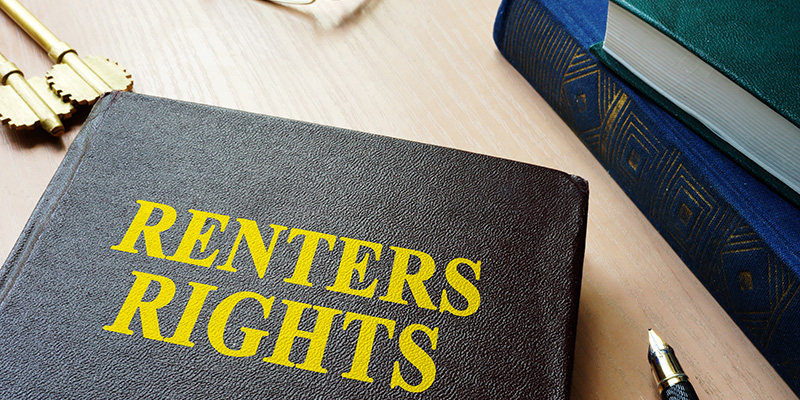The recently published Renter’s Bill of Rights aims to push state and local governments into establishing a standard set of renter’s rights. But what does it cover exactly? And how will it affect landlords?
What Is the White House Renter’s Bill of Rights?
President Joe Biden’s administration released a Blueprint for a Renters Bill of Rights in January 2023. It is a white paper that seeks to aid the development of policies that foster fairness for renters in the United States.
The White House Renter’s Bill of Rights is a blueprint for state and local governments to follow. It is merely a statement of principles and is in no way binding. Therefore, it is not a U.S. government policy or law. The Renter’s Bill of Rights does not override, alter, or interpret any current policies or regulations at the federal, state, or local levels.
Renter’s Bill of Rights vs Tenant Bill of Rights
The Renter’s Bill of Rights and Tenant Bill of Rights are two interchangeable terms. Many states already have Tenant Rights in place, and you can check the regulations per state through the HUD website.
Depending on where you are, rights may already be established by law. These include the right to freedom from discrimination, the right to a habitable home, the right to privacy, the right to advance notice of eviction and the right to a disability accommodation.
The Fair Housing Act and state-level fair housing laws also protect Americans from housing discrimination based on certain protected classes.
The Purpose of the Renter’s Bill of Rights
The main objective of the White House Blueprint for a Renter’s Bill of Rights is to create a standard that state and local governments can use when crafting their own renter’s rights. First and foremost, it serves the renters by offering them government protection against predatory or unfair practices by landlords and rental property owners.
Landlord and tenant laws vary immensely from one state to another. Some states have laws that heavily favor landlords, while others heavily favor renters. Biden’s blueprint intends to provide some relief to renters in more landlord-friendly areas.
While renter’s rights have certainly become a hot topic, the primary concern of many tenants in the United States today is rent — specifically rising rent prices. Unfortunately, the Renter’s Bill of Rights does not address this issue, instead focusing on unlawful or unfair practices. And experts believe it is unlikely that the White House would directly interfere with rent prices or rent control laws.
What Does the Renter’s Bill of Rights Cover?
The Blueprint for a Renter’s Bill of Rights lists down five basic principles. The blueprint explains each principle and details proposals that federal agencies can use to take action.
1. Access to Safe, Quality, Accessible, and Affordable Housing
 The first principle talks about the safety, affordability, and habitability of housing. While the blueprint does not specifically restrict rent increases, it states that any increases should be reasonable, fair, and transparent.
The first principle talks about the safety, affordability, and habitability of housing. While the blueprint does not specifically restrict rent increases, it states that any increases should be reasonable, fair, and transparent.
Renters should pay only up to 30% of their household income on housing costs. It explains that rental property owners should make sure to provide housing that meets habitability standards. No safety or health hazards should also exist.
Additionally, owners should offer amenities and services as they advertised or included in the lease. Owners should also ensure proper maintenance of the housing unit and common areas. Furthermore, it must not be unnecessarily difficult for renters to apply for or receive housing aid. Renters should also have a right to fair and equal tenant screening.
2. Clear and Fair Leases
Landlords should provide fair leases with clearly defined terms, responsibilities, and rights. There is no room for mandatory arbitration clauses, hidden or unlawful fees, unfair or deceptive practices, unauthorized terms, and false representations. Policies should be clearly and transparently laid out, especially regarding security deposits.
If the landlord intends to enter the unit, they must provide reasonable notice in advance. The same goes for any significant changes to the unit. Landlords must write the lease in a way that uses clear, simple, and accessible language.
3. Education, Enforcement, and Enhancement of Rights
The blueprint encourages federal, state, and local governments to do their part to protect renter’s rights. It also pushes governments to educate renters about their rights and to recognize discrimination and exclusion in all forms.
4. The Right to Organize
The blueprint states that renters should have the right to organize without interference. Housing providers, including landlords and property managers, should not harass renters or threaten them with eviction when they decide to organize. Renters should also know who their landlords or property managers are and have a way to communicate with them.
5. Eviction Prevention, Diversion, and Relief
 Landlords should use fair and legal eviction proceedings. The blueprint also proposes that all evictions should have a just or good cause. That means landlords can’t evict renters without a justified reason. Renters should also receive reasonable notice if landlords intend not to renew their lease.
Landlords should use fair and legal eviction proceedings. The blueprint also proposes that all evictions should have a just or good cause. That means landlords can’t evict renters without a justified reason. Renters should also receive reasonable notice if landlords intend not to renew their lease.
This principle also discusses other things, such as alternatives to the eviction system, proper procedures and requirements for evictions, how to file and seal eviction cases, and fair debt collection practices.
A Call for Property Management Companies to Follow Suit
While the White House blueprint certainly tackles several important issues, it does not constitute a law. It also does not compel state and local governments to act or craft renter’s rights. This has led some property management companies to take it upon themselves to establish their own bill of rights for renters.
The blueprint serves as a good guide for property management companies. In addition to the White House blueprint, companies should also look to state and local regulations regarding tenant rights. In doing so, companies can keep managers in check and provide more satisfactory services to renters and landlords alike.
A Starting Point
While the Renter’s Bill of Rights is not a law, it does let governments know where the goalposts are. It is a step in the right direction that will hopefully inspire legislators to enact more standardized laws that protect the rights of renters.
Rental Choice offers a comprehensive online directory of property management companies. Start browsing our directory today!
RELATED ARTICLES:
- What Is An Illegal Eviction? And What Can Tenants Do About It?
- 7 Renters Rights Every Tenant Should Know
- Is It Time To Hire A Landlord Tenant Attorney?




 Company
Company